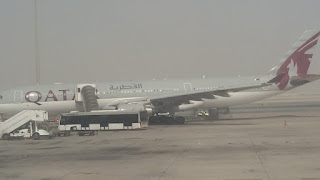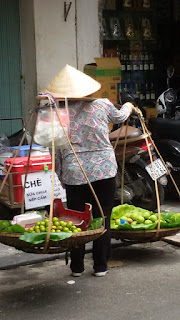Mwenye pupa hadiriki kula tamu - "A Hasty Person Misses the Sweet Things." - Kiswahili Proverb
Waiting for our flight to Tanzania at the Suvarnabhumi airport in Bangkok, Thailand, I noticed a Muslim family sitting down for pizza. The two women were wearing burkas, and I became curious about how they managed to eat with their faces covered. From the corner of my eye, I watched as they lifted a little flap of fabric covering their mouths and carefully guided the pizza slices in from below. We were still in Thailand, but my cultural education had already begun.
We found our seats on the huge and roomy Qatar airlines airbus A388. (I don't think I've ever used the words "airlines" and "roomy" in the same sentence.) I noticed the young lady next to me reading a book with Vietnamese writing, familiar to me because of our recent trip to Hanoi. We struck up a conversation, and I learned that she was travelling from Hanoi, Vietnam to Bangkok, Thailand to Doha, Qatar to Oslo, Norway on her way to begin her second year of schooling there. She attends an international college that accepts only 200 students per year, each one from a different country. Sounds like an awesome experience. She enjoyed practicing her English with us, and said she thinks it's "cute" when older couples travel together. Yeah, I guess we are getting to that age - sigh.
We arrived in Doha around midnight for a nine-hour layover. It was my first time in the Middle East, and I was fascinated by the variety of dress - hijabs and burkas of every style on the women, and men in long white garments called thawbs. In various shades of white, gray and tan, these were sometimes a below-the-knee shirt over pants, a floor-length robe, or two wraps - one around the waist, another around the torso and over one shoulder. These were plain, patterned, some even looked like towels. I just happened to read an article in the New York Times Magazine about the 21st century version of the pilgrimage to Mecca, and learned these two pieces of white, towel-like cloth are called ihram, and are worn to convey a state of purity and human equality. Many men wore white or red-and-white scarves, held onto the head with a black band called an agal, or iqal for you Scrabble enthusiasts. Many sheikhs(?) appeared to be accompanied by multiple wives. It was enlightening to be in a place where this Middle Eastern dress is commonplace, and no one is reacting with fear or suspicion. Of course, many people were wearing western style clothing as well in this international hub.
We were able to procure a room in the Airport Hotel and got some sleep before continuing on to Tanzania. I had hoped we would be able to get one of the room-by-the-hour rates, but of course those were not available, so we had to pay full price. It was very nice to be able to shower and sleep between flights.
 |
| crossing the Arabian peninsula |
 Our plane from Doha to Tanzania was much smaller and not nearly as roomy. This flight lands for a sixty minute "technical" stop on the island of Zanzibar, where they let off some passengers and change crews before continuing on to Kilimanjaro International Airport. Zanzibar facts: In the late 1600's, the sultanate of Oman took control, and developed an economy of spices (hence the Spice Islands), ivory and slave trading. In the 1800's, it became a British protectorate and the slave trade was abolished. Zanzibar gained independence from Britain in 1963. The former countries of Zanzibar and Tanganyika united to form the United Republic of Tanzania in 1964. Both maintain a degree of autonomy with their own presidents.
Our plane from Doha to Tanzania was much smaller and not nearly as roomy. This flight lands for a sixty minute "technical" stop on the island of Zanzibar, where they let off some passengers and change crews before continuing on to Kilimanjaro International Airport. Zanzibar facts: In the late 1600's, the sultanate of Oman took control, and developed an economy of spices (hence the Spice Islands), ivory and slave trading. In the 1800's, it became a British protectorate and the slave trade was abolished. Zanzibar gained independence from Britain in 1963. The former countries of Zanzibar and Tanganyika united to form the United Republic of Tanzania in 1964. Both maintain a degree of autonomy with their own presidents.It was a new experience to sit in a plane for an hour as it was being cleaned. I thought we might have been allowed to disembark, but had to stay in our seats the entire time. At least I could kneel up on my seat, facing the back of the plane, just to change up my position. I noticed everyone still on the plane was white, and felt a bit embarrassed by our privileged status. The crew came through and asked everyone to identify their stuff in the overhead bins, to make sure nothing was left behind by the exiting passengers. New passengers came aboard, and our pilot, with an attractive Italian (?!) accent, finally announced our departure.
 |
| Every time we took off, we had to watch this ridiculously long, soccer-themed safety video twice - once in Arabic, once in English |
 |
| The appearance of FC Barcelona's Gerard Pique causes oxygen masks to drop for his swooning fans |
 |
| The azure waters of the Spice Islands |
We landed at Kilimanjaro International Airport around four in the afternoon, after getting a peek at the top of Mt. Kilimanjaro sticking up through the clouds. We walked across the tarmac to a little building, where we had to fill out a mimeographed form with all our deets. Stepping to window number one, our paperwork was checked, and we handed over our $100 USD for our Tanzanian visa. Americans have to pay $100, while most other countries only pays $50 - interesting. I, however, am used to the double standard, as Thailand businesses routinely have two-tiered pricing, one for locals and a higher one for foreigners.
 |
| (Ted's pic) |
Our guide for the trip, Geoffrey, was waiting for us outside with a sign that said "Liz and Family." Assuming I was the only Liz, we introduced ourselves and made our way to the safari-style vehicle. Geoffrey said he had been waiting for us there since one o'clock! I didn't realize the time of the flight had changed from the original information I'd received. He was counting on having time to drive us to the hotel, then go back for the boys. But now it didn't give him enough time, and he had to call someone else to go pick up the guys at the airport. This didn't feel like a very good start to the trip.
It was a long, bumpy drive from the airport to the hotel, and Geoff called our attention a major road construction project being done by the Chinese. He pointed out the Chinese job bosses when we passed. It's something of a novelty here, I guess. He also pointed out that we would see many young Maasai males dressed all in black, with white chalk patterns on their faces. These teenage boys have reached the age of circumcision, called emorata, and wear all black for about six months. After this, they are considered warriors and help protect the tribe. We saw several groups of young boys like this, which could be a bit alarming if you didn't know the reason.
 |
| The African Tulip Hotel (Mike's pic) |
I was sick to my stomach by the time we arrived at the African Tulip Hotel in Arusha, maybe motion sickness. We were greeted with glasses of fruit juice and warm washcloths, a ritual that would be repeated at each of our stops. The manager welcomed us and we climbed the stairs to the third floor, with the staff hauling our luggage up for us. The first of many, many tips were paid here. Our room was a family suite, with two bedrooms, two baths and a sitting room. I immediately laid down on the bed to try to settle my stomach. The boys arrived a couple of hours later, and we went down for a late dinner. I couldn't really enjoy this long awaited reunion with my stomach doing gymnastics. I shouldn't have, but I had ginger ale and a piece of chapati bread, the unleavened, pan-grilled bread popular in east Africa. Let's just say the results were not pretty. The guys stayed up visiting for a bit, but I could not join them. I was so disappointed.
 |
| "Freshly Homemade Mandazi" |
 |
| buffet meal (Ted's pics below) |






















































































































